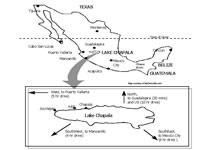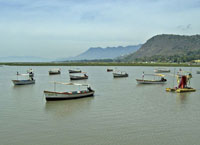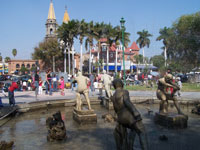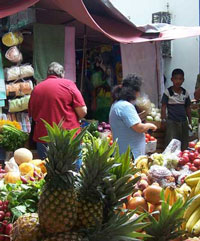Our Little Pocket of Paradise is a Haven for Mexpats
 Lake Chapala, nestled in a mountain valley just 50 minutes south of Guadalajara and 25 minutes from the international airport, is the largest inland body of water in Mexico.
Lake Chapala, nestled in a mountain valley just 50 minutes south of Guadalajara and 25 minutes from the international airport, is the largest inland body of water in Mexico.
It is 66 miles(106 kilometres) long and 13 miles (21 kilometres) wide and is situated on the border between the states of Jalisco and Michoacan and approximately a 3 ½ hour drive from the Pacific ocean. The most popular area for “Mexpats” (Canadians, Americans, Europeans) is located on the northwestern shoreline and is made up of a series of small villages over a 20 km stretch from Chapala to Jocotepec, referred to by locals as “Lakeside,” with the villages of San Antonio, Ajijic, San Juan Cosala and El Chante in between.
Lake Chapala has become a retirement haven for Canadians, Americans and Europeans; people from all over the world come to enjoy the warm days and cool nights along the shores of our beautiful lake. Crimson sunrises and golden sunsets serve to heighten their enjoyment of each majestic day.

Though you will find Mexpats in every village, the majority live in the various sub-divisions between Chapala and Ajijic (pronounced Ah-He-Heek). Some say this area has a micro-climate and that it rates as being the “2nd Best Climate in the World” refers to this particular stretch of the Lakeside.
Chapala – the largest community lakeside.
 Chapala, the largest of the six Lakeside communities was founded in 1538 and has been called home by such notables as President Porfirio Diaz and D.H. Lawrence (who wrote “The Plumed Serpent” while staying in the main house of the Quinta Quetzacoatle Inn); many large properties along the lake were weekend homes to wealthy people from Guadalajara and Mexico City and also to some of the rich and famous from Mexico, the United States and even Europe.
Chapala, the largest of the six Lakeside communities was founded in 1538 and has been called home by such notables as President Porfirio Diaz and D.H. Lawrence (who wrote “The Plumed Serpent” while staying in the main house of the Quinta Quetzacoatle Inn); many large properties along the lake were weekend homes to wealthy people from Guadalajara and Mexico City and also to some of the rich and famous from Mexico, the United States and even Europe.
Though many of these houses have been converted into commercial sites (B & B’s, restaurants, hotels, etc), many beautiful homes still remain “behind the walls” and visible from a boat ride on the lake.
Driving from Guadalajara (or the airport) to Chapala, you pass through a short mountain pass and, as you head down and turn the first corner, you get your first breathtaking panoramic view of the lake with Chapala nestled on its shoreline. Entering the town, you travel along a wide boulevard passing a variety of small stores (tiendas), the plaza and its indoor market, the commercial center with several Banks and the “Municipal Palace” (City Hall) and a beautiful church.
On weekends, at the end of the boulevard, in an area stretching along the lake, you will find, locals and visitors alike, shopping at the myriad of stalls where vendors display everything from clothing, leather goods, arts and crafts, toys, musical instruments, food and many more interesting items. You’ll find people taking boat rides to Alacran (Scorpion) Island, or eating at one of the many restaurants and enjoying the local strolling musicians. And others, just sitting on the park benches relaxing by the lakeside. Weekends are always family affairs in Mexico and it is wonderful to see the Dads looking after the baby and the older children caring for the youngsters, giving Mom some time to relax.
 Close by you will find the Los Cazadores Restaurant located in a well-groomed old Victorian house, formerly owned by the Braniff family – airline pioneers in the USA.
Close by you will find the Los Cazadores Restaurant located in a well-groomed old Victorian house, formerly owned by the Braniff family – airline pioneers in the USA.
During the week, Chapala is the business center for the area but weekends are a hive of activity.
From Chapala, you head west along the lake’s shoreline passing the residential areas of Riberas del Pilar, Mirasol, Chula Vista (with its beautiful lush Golf Course), San Antonio, La Floresta and on to the village of Ajijic. We also have a well used Ciclopista (bike and walking path) running parallel to the Carreterra.
San Antonio, the major shopping area is where you’ll find Superlake (what locals call a “SuperMercado” or super market). It is a fully stocked grocery store and offers just about any imported good you can think of. Ten years ago when we first arrived there were lots of things we used to stock up on when we went back home for visits (Campbell’s Tomato Soup and HP Sauce to name a couple), but now there is little we can’t get here right in Lake Chapala – Cajun spices, Japanese wasabi and even Sushi). Plus we now have a WalMart here and Sam’s and Costco are less than an hour’s drive away.
Taking a side trip along the way into the sub-divisions, you will find homes of all types, from small village homes to grand haciendas and beautiful architect-designed homes set in lush gardens landscaped with every conceivable type and color of flowering trees and plants. From the “mountain side” homes your vista will include incredible lake views with Mount Garcia in the background (the top of the mountain looks like the profile of a molded lady lying down, watching over her domain and is referred to as “Our Lady of Chapala”) You will also find that the streets are lined with flowers and trees, changing color from season to season.
Ajijic – the most popular place for visitors and residents
Truly representative of the typical Mexican pueblo with its narrow cobblestone streets and central plaza, this 450 year old village is the most popular place for visitors and residents alike. The very colorful buildings along the main street from the “Carretera” to the lake and surrounding the plaza are home to a wide variety of tiendas (shops) where you will find jewelry, clothing, art galleries, corner stores, gift shops, and many fine restaurants offering a wide variety of cuisine from many parts of the world.
 On Wednesday mornings the local Tianguis (outdoor market) set up, taking over several blocks with their wares. Here you can shop for groceries, dishes, pots and pans, arts and crafts, jewelry (Mexico is famous for its silver), clothes, bedding, shoes, flowers, candies and even food – ready to enjoy; from pizza to tacos to pozole (pork and hominy stew). You’ll see colorful and creative displays of not only fruit and vegetables but just about everything they sell is artistically arranged. You really appreciate the pride that goes into this work when you realize the Tianguis are set up in the early morning in a different village each day and taken down by late afternoon.
On Wednesday mornings the local Tianguis (outdoor market) set up, taking over several blocks with their wares. Here you can shop for groceries, dishes, pots and pans, arts and crafts, jewelry (Mexico is famous for its silver), clothes, bedding, shoes, flowers, candies and even food – ready to enjoy; from pizza to tacos to pozole (pork and hominy stew). You’ll see colorful and creative displays of not only fruit and vegetables but just about everything they sell is artistically arranged. You really appreciate the pride that goes into this work when you realize the Tianguis are set up in the early morning in a different village each day and taken down by late afternoon.
The plaza is a traditional gathering place where, during the day friends meet just sit and chat and in the evenings, families go to watch the entertainment, snack from the food vendors and on Sundays, chaperone the young men and girls who walk the plaza in a traditional courting ritual. [It is also the center of activity for fiestas when many people gather to celebrate the occasion with music and dancing and fireworks (including a tall structure called a Castillo) with a series of fireworks that ignite in a series to create a fantastic display].
As you stroll the areas surrounding the main street and the plaza you will come across numerous small stores intermingled with small village homes. It is quite amazing what you will come across as different shops open and close at different hours and as one shop closes, the paint on another across the street is just going on.
As you move further out, you will find the residential area with a wide variety of homes, quite often surrounded by high walls. When you see an open gate, take a peek inside. You never know what you might find. It could be an empty overgrown lot, a little lean to or a magnificent estate home in a park-like setting. On the Lakeside there is so much fascination with what’s “behind the walls” that often a local charity will organize a “behind the walls” tour allowing people to see some of these incredible homes that are normally well hidden from view. Alison Pickering, an incredible artist had the idea to create a full color book called “Behind the Walls,” full of interior and exterior pictures of homes; with most of the proceeds going to a local charity – The School for the Deaf. The success of this book has been enormous and each additional printing continues to sell out.
Taking a short walk to the east, you will pass some homes that have been converted into B & B’s, a former hacienda that is now one of our favorite restaurants (La Bodega), on the lakeshore the Hotel Real de Chapala set in a huge expanse of exquisitely manicured gardens (the setting for the Focus programs) and the subdivision of La Foresta, again with an incredible variety of homes set along wide boulevards–some with trees growing in the middle of the street!
To the north of the Carreterra (the main road from Chapala to Jocotepec) the terrain is higher and you will find residential areas where the homes have incredible lake views where you can watch the sun rise and set in the most beautiful display of color, always watched over by “Our Lady of Chapala.”
Keep receiving our updates on life at Lake Chapala by subscribing to our email Newsletter. Click here and tell us where to send your updates!


Leave a Reply